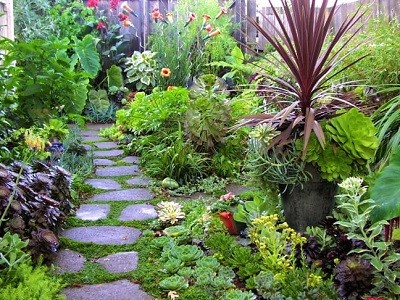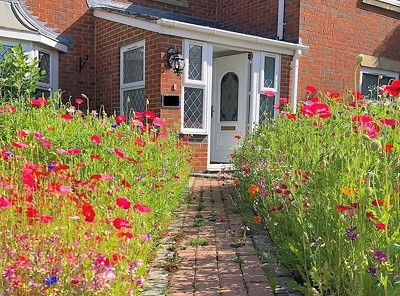Nature Friendly Gardens

There are over 15 million gardens across the UK, which adds up to be an area bigger than all our National Nature Reserves combined! This means that the way we design our gardens is really important for preserving and nurturing our local biodiversity. Nature friendly gardens provide habitats for local wildlife, by incorporating native plants, water features and shelter options to attract birds, butterflies, bees, and other beneficial insects which in turn fosters a thriving ecosystem right in our neighbourhoods.
On the other hand, gardens with excessive paving and artificial grass create a sterile environment, increasing our carbon footprint, our flood risk and urban temperatures, leaching plastic into soils and pushing wildlife away. Currently, over half of UK’s front gardens are covered in hard surfaces.
Creating your own nature friendly garden will play a crucial role in sustaining our local ecosystem, promoting biodiversity, and enhancing the beauty of our environment. Together, we can make our communities a haven for both people and wildlife!


Top Tips for Nature Friendly Garden
Swap paving and artificial grass for plants
Ditch your artificial lawns / paving and allow sections of your natural grass to grow long, especially during the summer months! Even better, why not try making your own small wildflower meadow?
Check out a guide here: How to grow a wild patch or mini meadow | The Wildlife Trusts
Plants for pollinators
Some plants are much better for encouraging wildlife than others, keep an eye out for plants with an RHS 'plants for pollinators' badge.
Consider buying plants for all seasons, so you are providing a food source for wildlife throughout as much as the year as possible.
Example plants for butterflies, bees and caterpillars include:
- Spring - Primroses, Forget-me-not, Cuckoo flower
- Summer - Corn flower, French Marigold, Thyme, Lavender, Sage
- Autumn - Flowering Ivy, Buddleia, Verbena, Chrysanthemum
- Winter - Flowering Crocus
Don't turn your nose up at dandelions! Some of plants that we traditionally think of as unattractive or weeds can actually be beneficial for wildlife. It's always good to check online first, before removing any of your plants.
Be creative with your space
You don't need a massive garden to make a difference, even small spaces can be made more nature friendly!
Planter boxes and raised beds are a great way to increase your plant coverage. You can also include plants that grow up walls/trellises: How to create a vertical garden | The Wildlife Trusts
Avoid pesticides and artificial fertilisers
Pesticides often harm nature. Check out this guide for alternative techniques: Gardening without pesticides - Pesticide Action Network UK (pan-uk.org)
Using fertilisers, especially artificial ones, isn't always the best choice for your garden or the planet. For example, wildflower species native to the UK flourish in low nutrient soil. How to care for your soil / RHS Gardening
Get to know your garden
Different plants and wildlife thrive in different conditions, so its important to learn more about your garden in order to design it in an effective way. Some things to think about include:
- Soil type
- Direction of sunlight e.g. is your garden south facing?
- Areas of shade
- Level of rainfall
Nowadays you can also install identification apps for plants, mushrooms and wildlife on your smart phone to help learn what's happening in your garden
Front Gardens and Driveways
Here's a handy guide for helping make your front garden more nature friendly:
- Nature Friendly Front Garden Design
- Download (11.6MB - PDF)

Back Gardens
There are lots of ways to look after different types of wildlife in your garden:
1. Get a compost bin and/or make a leaf mould
2. Build a pond or even a bog garden
- Mini pond guidance - How to create a mini pond | The Wildlife Trusts
- Bog Gardens - How to make a bog garden | The Wildlife Trusts
3. Help look after birds too
- How to build a bird box | The Wildlife Trusts
4. Build a bug/bee hotel and a bat box
- How to make a bee hotel | The Wildlife Trusts
- How to build a bug mansion | The Wildlife Trusts
- How to build a bat box | The Wildlife Trusts
5. Make a log pile shelter for a variety of creatures
Things to avoid!
- Compared to other plants, they often lack the nectar and pollen insects need
2. Over watering and using 'new water'
- Established lawns need watering less than you might think
- Plants love rainwater best. Use a water-butt to collect rainwater, which also helps to reduce your water bills!
3. Binning your plant waste straight away
- Leave plant deadheads until mid-winter, to provide a home for insects
- Use fallen leaves in a leaf mould
4. Too much artificial light pollution can harm wildlife and affect your plants growth cycles
- Turn off your garden lighting when not in use or opt for 'low intensity lighting'
5. Don't use peat compost
- Peat compost comes from lowland peat bogs which are an important habitat for wildlife
- When damaged, bogs also emit large amounts of carbon dioxide into the atmosphere.
Why not join Team Wilder?
By joining #TeamWilder you’ll gain access to a wide range of enriching resources and more!
Find out more - here!
Further Guidance
For more information on creating nature friendly gardens in the UK, several reputable sources offer valuable advice and resources. Here :
- The Royal Horticultural Society (RHS) - RHS - Inspiring everyone to grow / RHS Gardening
- The Wildlife Trusts - Home | The Wildlife Trusts
- BBC Gardeners' World - Wildlife Gardening | BBC Gardeners World Magazine
- The Woodland Trust - UK's Largest Woodland Conservation Charity - Woodland Trust
- Butterfly Conservation - Home page | Butterfly Conservation (butterfly-conservation.org)
- The RSPB (Royal Society for the Protection of Birds) - RSPB
- The Garden Wildlife Health Project - Garden Wildlife Health
- Bug life - Resources - Buglife
- Pesticide Action Network UK - Gardening without pesticides - Pesticide Action Network UK (pan-uk.org)
